DOWNLOADING MOVIES
|
| < Day Day Up > |
|
Because movie files are typically huge, most people break them into parts so that others can download the individual parts that they need, rather than downloading a single, massive file. Not only can small files be downloaded faster, but more people are likely to offer them, so it increases the chances that you can download the same file from multiple sources. Figure 10-4 shows an example from Kazaa.
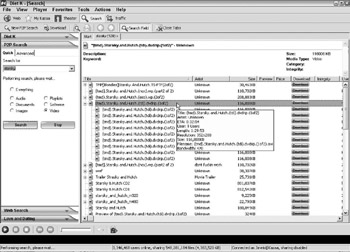
Figure 10-4: Many movies appear on file sharing networks, divided into several smaller files.
Just because you happen to find a file that contains a movie you want, it doesn’t necessarily mean that the video quality will be good enough to make the movie worth watching. Besides people filling the Internet with poor quality videos, the movie studios themselves often hire companies, such as MediaForce, which purposely flood a file sharing network with bogus movie files that contain nothing but static in an attempt to discourage video piracy.
When people download and view a video file that’s fake or of poor quality,-they often erase it right away rather than post it on a file sharing network for other people to waste their time downloading and viewing. As a result, you can find the highest quality files by reviewing the sizes of all available files to determine which file size appears most often. For example, if you want to download the second part of the movie Spider-Man 2, you may see a dozen files listing the file size as 116,458KB but just one similar file with a size of 125,795KB. Chances are good that the 116,458KB file will be the best copy, which is why so many people have and distribute it.
To save time when you are looking for a particular file, try using a search engine like FileDonkey (http://www.filedonkey.com) or Sigster (http://www. sigster.com). As shown in Figure 10-5, these tools can search through multiple file sharing networks for the files you want.
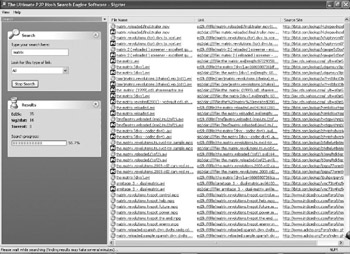
Figure 10-5: Programs like Sigster can pinpoint the location of your chosen file, no matter which file sharing network it may be found on.
While file sharing networks like Kazaa can be great for finding and downloading MP3s, they’re not ideal for finding and downloading full-length movies that gobble up several hundred megabytes of storage and take hours to download.
To download large files, many people now use BitTorrent, a file sharing program designed specifically to distribute large files. Just install BitTorrent (http://bitconjurer.org/bittorrent) or one of its variations, like BitTornado (http://bittornado.com) or BT++ (http://btplusplus.sourceforge.net), and then search in a web browser for a “torrent” that contains the files you want, or visit a hash-file link site, such as Up2dat (http://www.up2dat.com). Once you find a file you want, just double-click it, and BitTorrent will start downloading your movie.
In addition to posting movies on file sharing networks, many people also post movies in newsgroups. Unlike file sharing networks, where movies are often broken into just a few parts, newsgroups often break movies up into dozens, sometimes even hundreds, of files stored in the RAR file format, a popular file compression format. To learn more about RAR files, see the following “Using RAR files” section.
Downloading and collecting hundreds of separate RAR files to make up a single video may be a daunting task, but it can be even more frustrating if a handful of files are missing or corrupted. To avoid this problem, many people also include PAR and PAR2 files with RAR files. PAR and PAR2 files can help you recreate missing RAR files, as explained in the “Recovering missing RAR files with PAR and PAR2 files” section later in the chapter.
Newsgroup file sharing isn’t a high-profile way of sharing video files, unlike the file sharing networks, so you’re less likely to find novices and malicious users flooding the newsgroup with poor quality or bogus files. Breaking up a huge video file into multiple RAR files also makes newsgroups a cumbersome way to download videos. The initial complexity involved in breaking up and posting a video file to a newsgroup helps ensure that only dedicated users will actually post files, and these users tend to take pride in posting high-quality video files.
To find movies in newsgroups, head for these main newsgroup categories and see which branches your newsgroup server carries:
-
alt.binaries.dvd
-
alt.binaries.movies
-
alt.binaries.movies.divx
-
alt.binaries.multimedia
-
alt.binaries.vcd
USING RAR FILES
Any video files you’ll find in a newsgroup will likely be compressed in multiple RAR files. Basically, the RAR format can split massive files like movies and TV shows into smaller, consecutively numbered files, making them easier to share on newsgroups. Users post the numbered pieces over several days, thus avoiding any bandwidth limits that may be imposed by their Internet service provider. Swappers, in turn, log on over several days and download the latest pieces. Once they’ve downloaded all of the file parts, WinRAR or another RAR program combines the pieces into the original file.
The key to downloading videos divided into RAR files is grabbing all of the pieces. For example, have a look at the three parts of a Sex and the City episode, shown in Figure 10-6.

Figure 10-6: Download the initial RAR file and every consecutively numbered RAR file immediately following.
This large file has been split into two types of files.
-
The first part is the single file that ends with the .rar extension.
-
The subsequent parts are the consecutively numbered files with extensions such as .r03, .r04, .r05, and so on.
You must download all the parts in order to extract the entire video, as shown in Figure 10-7.

Figure 10-7: Once you’ve downloaded all the parts of an RAR compressed file, WinRAR can combine them to extract the original file.
Newer versions of RAR (versions 3.0 and later) simplify the numbering format slightly by giving all the files a .rar extension and inserting part numbers into the file names, as shown here:
HBO - Sex and the City - An American Girl in Paris.part1.rar (*/23) HBO - Sex and the City - An American Girl in Paris.part2.rar (*/23) HBO - Sex and the City - An American Girl in Paris.part3.rar (*/23) HBO - Sex and the City - An American Girl in Paris.part4.rar (*/23) HBO - Sex and the City - An American Girl in Paris.part5.rar (*/23) HBO - Sex and the City - An American Girl in Paris.part6.rar (*/23) HBO - Sex and the City - An American Girl in Paris.part7.rar (*/23) HBO - Sex and the City - An American Girl in Paris.part8.rar (*/18)
RECOVERING MISSING RAR FILES WITH PAR AND PAR2 FILES
Few things are more frustrating than downloading 105 pieces of a movie, only to find that your news server choked on four of the pieces, leaving your movie with several short gaps. You can leave a message, begging the uploader to resend your missing files. But what if somebody else’s news server choked on different pieces of the same movie? With the newsgroup’s global reach, an uploader could spend days or weeks reposting missed pieces. The solution to this modern dilemma hails from a 1960s algorithm known as the Reed-Solomon error-correction protocol, used previously for correcting errors in data storage and satellite broadcasts. When packaged in a program called SmartPar (http://parchive.sourceforge.net/#clients), that same formula keeps uploaders from needing to constantly repost missed files.
Here’s how it works: Before uploading all the pieces of their movie, uploaders run SmartPar to analyze the data. SmartPar places its analysis in a small file named “PAR.” The program also grabs integral data bits from the movie and places them in several “recovery” files bearing consecutive numbers: P01, P02, P03, P04, and so on. The uploader posts all the movie’s pieces, the PAR file, and the sequentially numbered recovery files. Yes, this requires more time and effort. But it’s worthwhile, because those four PAR files can recover any four missing movie files.
Downloaders grab all the movie’s pieces and the PAR file, then run their own copy of SmartPar. If the program discovers that the movie is missing some pieces—three, for instance—they simply download any three of the numbered PAR files. SmartPar runs its error-correcting protocol on this data, and by using its formula on the PAR files and the recovery files, it reconstructs those three missing pieces.
Here’s an example. If SmartPar says your newly downloaded Sex and the City episode isn’t missing any RAR files, ignore the PAR files. They were a safety net that you didn’t need. But if SmartPar says one RAR file is missing or corrupt, download any one of the numbered PAR files to recover it. Missing two RAR files? Download any two of the numbered PAR files. But what if you’re missing four or more RAR files, and the uploader only posted three? Then you’re out of luck, unfortunately. You don’t have enough PAR file information to recover the four missing pieces.
PAR files have been around for several years, and a new, improved version-called PAR2 also has a large fan base. Which program should you use? It’s probably best to use PAR2, because many programs, including QuickPar (http://parchive.sourceforge.net/#clients), support both the PAR and PAR2 formats.
PAR2 works much like PAR, but with smaller recovery files that use a different-numbering scheme. For example, Figure 10-8 shows that an uploader used RAR to post a complete Sex and the City episode in 12 pieces (.r01, .r02, .r03, .r04, .r05, .r06, .r07, .r08, .r09, .r10, .r11, and the initial RAR file). The poster also thoughtfully included three PAR files (.par, .p01, and .p02), and seven PAR2 files (.par2, .vol00+01.par2, .vol01+02.par2, .vol03+04.par2, .vol07+08.par2, .vol15+16.par2, and .vol31+09.par2).
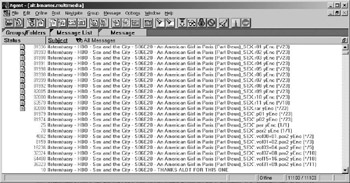
Figure 10-8: This Sex and the City episode is posted in RAR format, with both PAR and PAR2 files included for reconstructing a few missing, corrupt, or incomplete RAR files.
Although the PAR2 numbering scheme looks much more complex than the PAR numbering, it’s actually faster and easier to use. Download all the episode’s pieces and the first PAR2 file, and run QuickPar to examine your downloaded files, as shown in Figure 10-9.
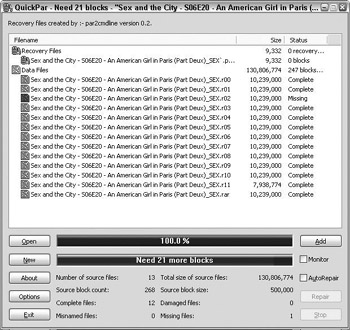
Figure 10-9: Double-click the PAR2 file in QuickPar, and the program tells you how many blocks you need to recover the missing files.
If all the RAR files came through fine, you don’t need to recover anything—don’t bother downloading the PAR or PAR2 files. But if QuickPar finds a corrupt or missing RAR file, QuickPar tells you how many “blocks” you need to recover that file. In Figure 10-9, for instance, QuickPar found a missing file and says you need 21 blocks to recover it.
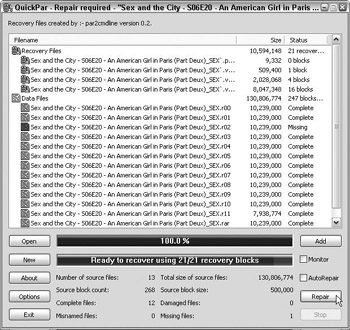
Figure 10-10: Once you’ve downloaded the required number of blocks in PAR2 files, QuickPar recreates the video.
So, how many blocks are in a PAR2 file? The PAR2 file’s numbering system-provides the answer: The last number before the .par2 extension reveals the number of blocks in each file. For instance, here are the six numbered PAR2 files from Figure 10-8. (Their block numbers are in bold):
.vol00+ 01.par2 .vol01+ 02.par2 .vol03+ 04.par2 .vol07+ 08.par2 .vol15+ 16.par2 .vol31+ 09.par2
Those PAR2 files contain 1, 2, 4, 8, 16, and 9 blocks respectively—a total of 40 blocks. That’s much more than 21; you could download them all to recover the missing file, or you can save time by just downloading the files with 1, 4, and 16 blocks. Those add up to exactly 21 blocks. Download those three files, and QuickPar uses their data to recover the missing piece, as shown in Figure 10-10.
|
| < Day Day Up > |
|
EAN: 2147483647
Pages: 98